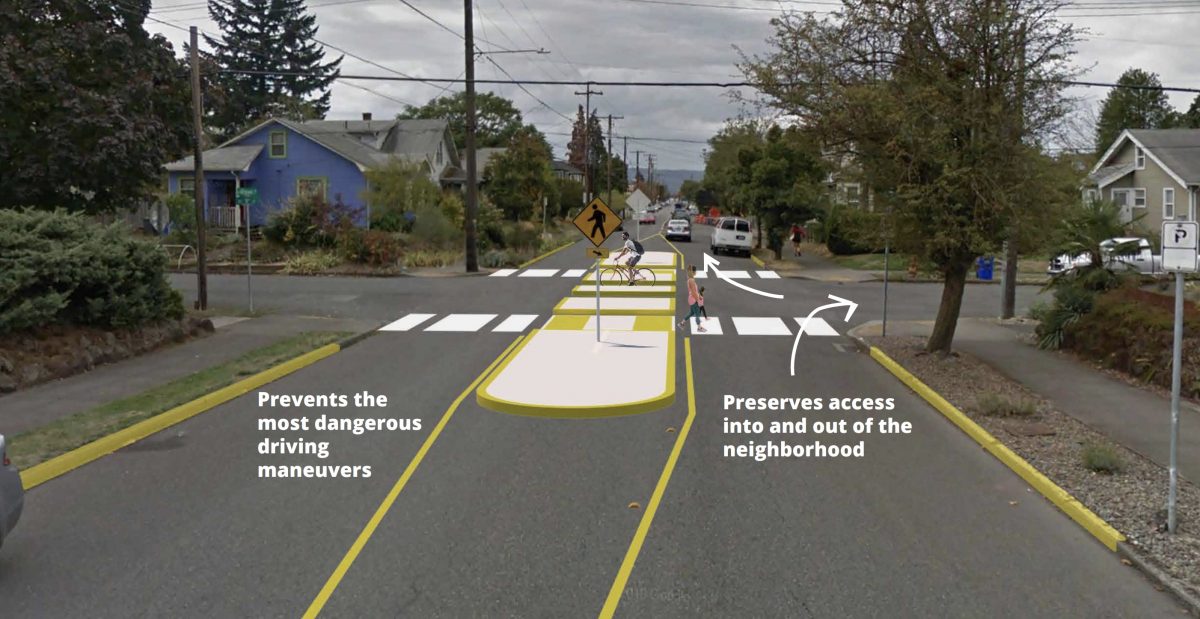
The city’s effort to create a low-stress, family-friendly street between the Lloyd and Woodlawn neighborhoods received yet another test last night. Despite steady rain there was a sizable turnout at a meeting held in the King Neighborhood to hear more about plans for the northern section of the project.
The Portland Bureau of Transportation began this project in March 2016. Back then they heard very strong support for traffic diverters on NE 7th Avenue, the street that makes a direct connection to the forthcoming Earl Blumenauer Bridge over I-84. When the plans were first released in July 2018 they were the most ambitious greenway concepts we’d ever seen. While many people celebrated the plans, others were incensed and felt that PBOT had once again failed to fully comprehend the existing anger around gentrification and legacy of institutional racism present in the adjacent neighborhoods.
PBOT has spent the past year working more closely with black residents and adjusting the plans accordingly. As recently as this past July, even a pared down version of the plan was met with anger and objection.
Last night they tried again. On the table was a single diverter they’d like to install on NE Killingsworth at 9th Avenue (see lead image).
Before the discussion began, PBOT Capital Programs Division Manager Millicent Williams tried to set the tone in a prepared statement she read prior to the official presentation:
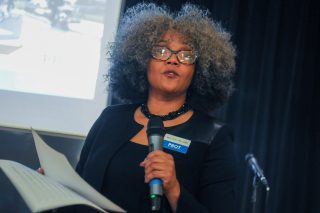
“We recognize that many of you in this room and in this community at large have experienced transportation-related trauma and pain. Some challenges dating back over 50 years… We recognize that if we are going to be a bureau and city that demonstrates care, concern, and compassion for all, we have got to acknowledge our contributions to that pain and perform our work differently. That is why we are here. While re-framing our overall work will take some time, there are things that we’ve already done and that we can do today to demonstrate our commitment to showing up differently. We are here to ask you about how you feel and what you think — not to just ask your opinion and check a box. We will use the information you share to inform our main planning, design — and ultimately construction — of a project that responds to your requests and reflects your desire, some that have been voiced for 40 years and have been unheard and unattended to. Tonight’s conversation is for you. Tonight’s conversation is about you. The decisions that are made will affect you. We want to hear the chorus of voices, discuss your opinions, demonstrate professionalism and responsiveness, and become your trusted partner… This is your community and your project, let’s work together to get meaningful outcomes.”
After Williams, a half-dozen PBOT staff presented on different aspects of the project.
PBOT Capitol Project Manager Nicole Pierce said the goal of the project was to, “Find other ways for people to move safely around the city,” and to create streets that pass the “basketball test.” “Where kids can play basketball in the street and not have to worry too much about traffic.”
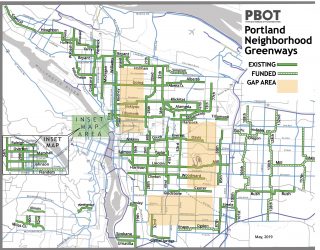
Project Manager Nick Falbo said this part of Portland is one of the remaining gaps in the city’s vaunted greenway network. He also apologized for PBOT’s last attempt. “We got it wrong. It was an over-engineered proposal that wasn’t grounded in community engagement and wasn’t well-received.” Falbo said the city heard loud and clear that their previous diversion plan for 9th was considered by some people as being, “overly restrictive to car traffic,” and “trying to solve a problem many in the neighborhood didn’t think they had.”
Falbo said PBOT’s new approach was to “find a lighter touch in this part of the neighborhood that could improve safety while still preserving neighborhood [driving] access.”
Advertisement
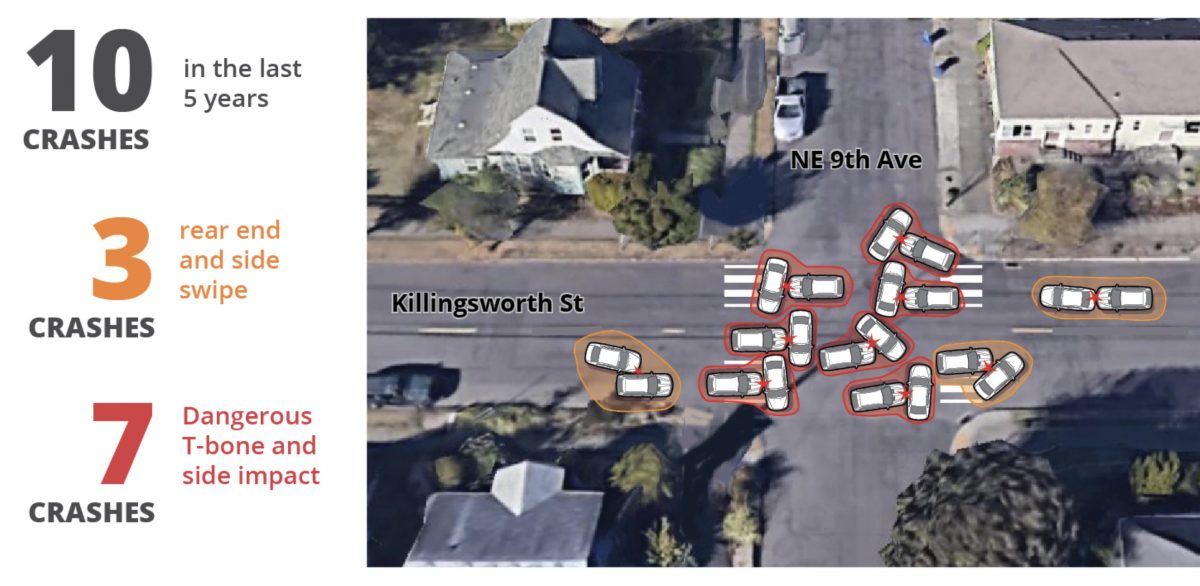
That “lighter touch” is to make relatively minor changes on NE 7th and create a greenway on 9th. There was no mention (and there hasn’t been any progress) of getting the route through Irving Park. The plan will do standard greenway treatments — speed bumps, fewer stop signs, 20 mph speed limit, striped crossings, and so on — for most of the route. The only traffic diversion would be at Killingsworth. That is, if PBOT feels enough people support it.
Throughout the meeting PBOT made it clear to attendees that the public would hold the power this time. “We want to put you in control,” Falbo said. One PBOT slide called their design merely an “idea” not a “proposal”.
The design is basic and it’s similar to many existing diverters citywide (such as N Rosa Parks and Michigan, NE Going and 15th, etc.). It would prohibit car and truck drivers from crossing Killingsworth at 9th. PBOT is already building a new crossing here with striped crosswalks and median islands as part of a Safe Routes to School project.
After the presentation, people were able to voice their concerns. They asked a barrage of questions, most of which PBOT was able to answer satisfactorily. Everyone who spoke out was opposed to the new diverter.
“We need to go down Killingsworth and we need to be able to come back,” one woman said. “And that doesn’t allow it.” She feared people would cut over a block sooner and “speed through” narrow side streets. “We have to live through this,” she said. “We already so no!”.
“What’s happening is that you’re appeasing a lot of the people that are coming into the community, and you need to listen to the residents!”
Another man was worried about congestion: “The fact that you have already taken away Williams and Vancouver and turned two lanes to one, it’s already created a lot of emissions from people waiting in traffic on MLK, and on 15th,” he said. “So why don’t you be more proactive and think about things that are actually going to speed up that traffic flow on MLK?! I use 9th because those other roads are already clogged up.”
A woman sitting nearby agreed with him. “I’ve lived in Oregon all my life. I know we have a lot of newcomers here… I don’t believe we need to be sitting in line with congested streets because they’ve taken lanes away and now the cars are backed up causing more pollution… What’s happening is that you’re appeasing a lot of the people that are coming into the community, and you need to listen to the residents!” (Note: Congestion and idling does not create more emissions than free-flowing traffic.)
Advertisement
At the end of the meeting I met Kellie Shaw, one of the outspoken critics of the project. She’s against the diverter in part because it would remove auto parking from the corners.
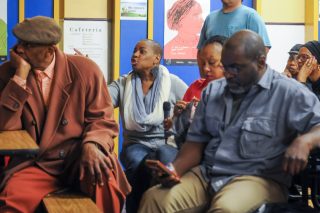
Don’t you think it’s safer to cross when you don’t have cars parking all the way to the corners? I asked. “I don’t deny those things. I have a three children and three grandchildren,” Shaw replied. “I do see safety benefits. However, as a property owner who has lived in this neighborhood for 48 years in the same home, I see the other side of it. I think you do not take the rights of one away to over-extend the rights of the other.”
What about the diverter and how it would reduce auto traffic on 9th by 10-15% so people can play basketball on the street?
“The reality is Portland has grown to where kids actually playing in the street, on 9th, isn’t going to happen. My kid knows to not play in the middle of 9th. 9th is an important through-way. There’s MLK, there’s 9th, there’s 15th. MLK is backed up, 15th is crowded too, 9th is the only through-way,” she said. “I don’t want a diverter that stops traffic from going through there. If you want to put in a speed bump to slow people down, I’m not even opposed to that. But to just arbitrarily cut traffic out, then you’re locking me into my own neighborhood. When I’m trying to get in-and-out. When I have to call a fire truck or an ambulance they can’t turn left*, those things become very real concerns safety-wise.” (*PBOT has vetted the design with the Fire Bureau and they have no problems with it.)
Shaw feels just having the painted crosswalks would a “happy compromise” and wants to see PBOT propose a different design.
Before everyone left, they were given a sticker to share their level of support on a poster. Here’s how it looked after nearly everyone had left:
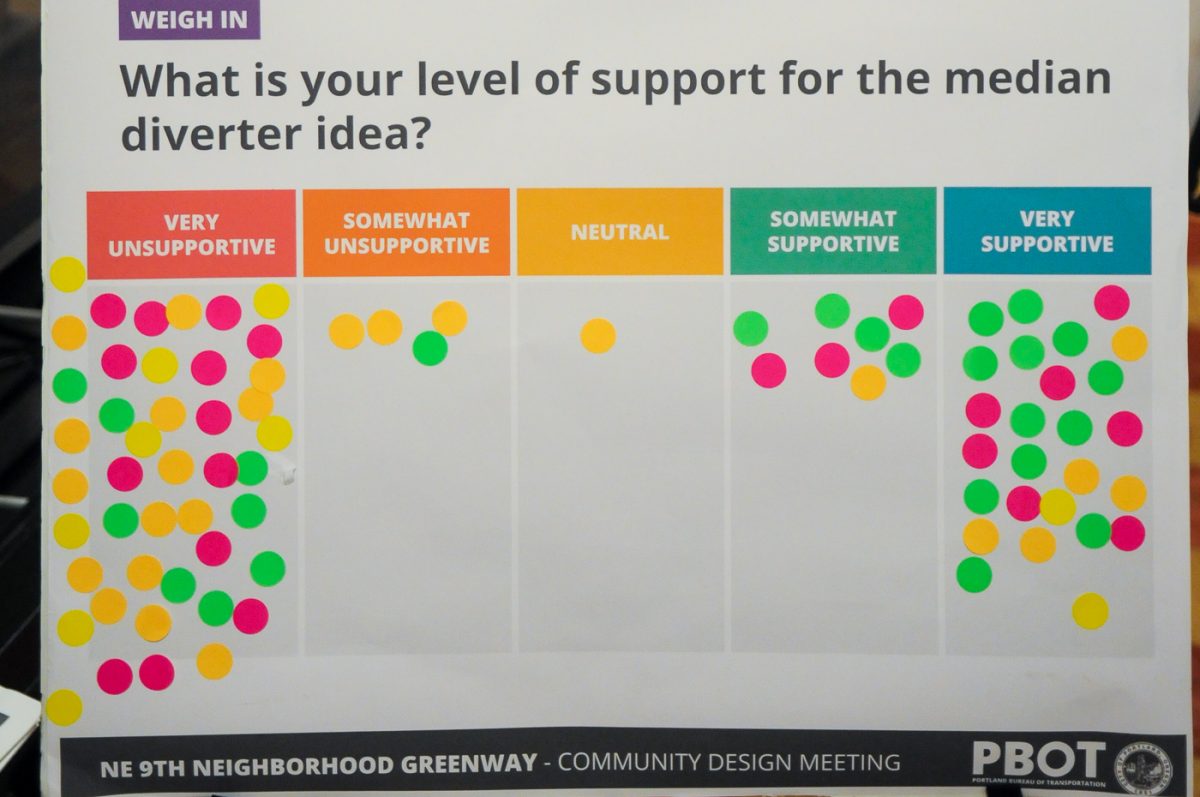
Clearly there was a lot of support for the diverter in the room; but no one spoke up about for it. John Lascurettes was there. He told me afterward that he didn’t want to contribute to the “argumentative tone”. He was also disappointed PBOT didn’t do more to rebut concerns. “When people talked about traffic causing more pollution, PBOT really needs to get in front of those statements with data that that’s just not how pollution works,” he said. “And more throughput only adds more cars which is what really adds pollution.” Lascurettes also thinks PBOT is giving neighbors too much power. “This is not a voting process, yet at the meeting it was presented as if it was. PBOT is serving people north and south of this too. I kind of have a problem with PBOT’s whole presentation at the meeting. Yes, we 100% want to listen to people that live in the ‘hood; but it was presented almost like ‘you get to vote on it’.”
PBOT has launched an online survey that will be open until October 27th. PBOT says they will make a decision very soon and it won’t simply be a tally of votes. I heard one staffer tell someone, “This isn’t majority wins. Our Director [Chris Warner] will decide, informed by this feedback.”
— Jonathan Maus: (503) 706-8804, @jonathan_maus on Twitter and jonathan@bikeportland.org
— Get our headlines delivered to your inbox.
— Support this independent community media outlet with a one-time contribution or monthly subscription.

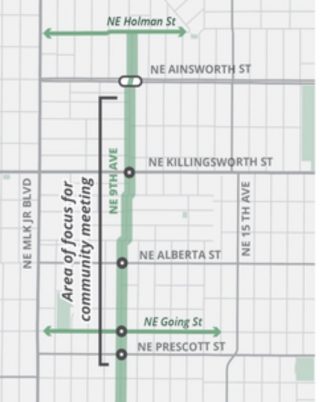
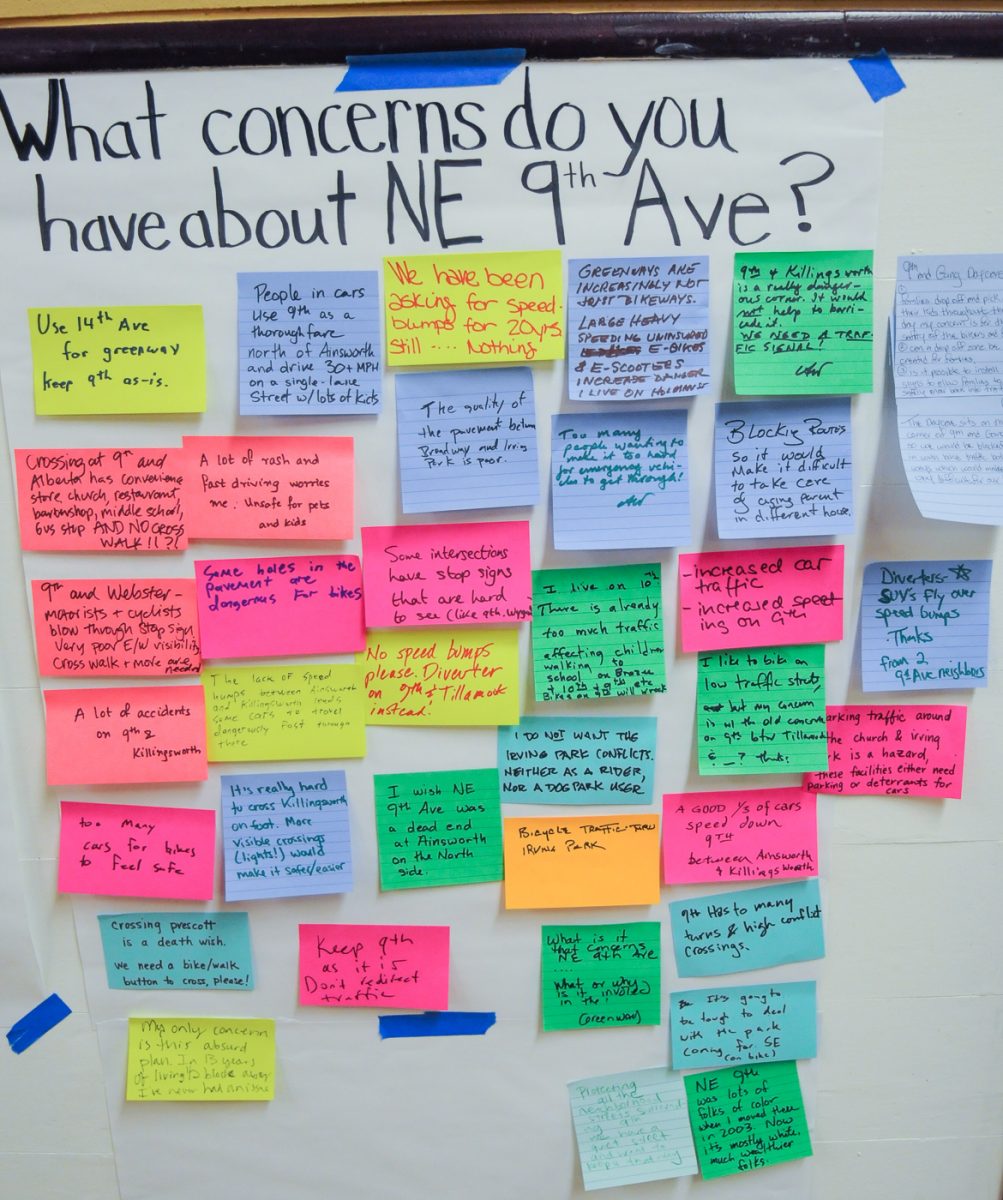


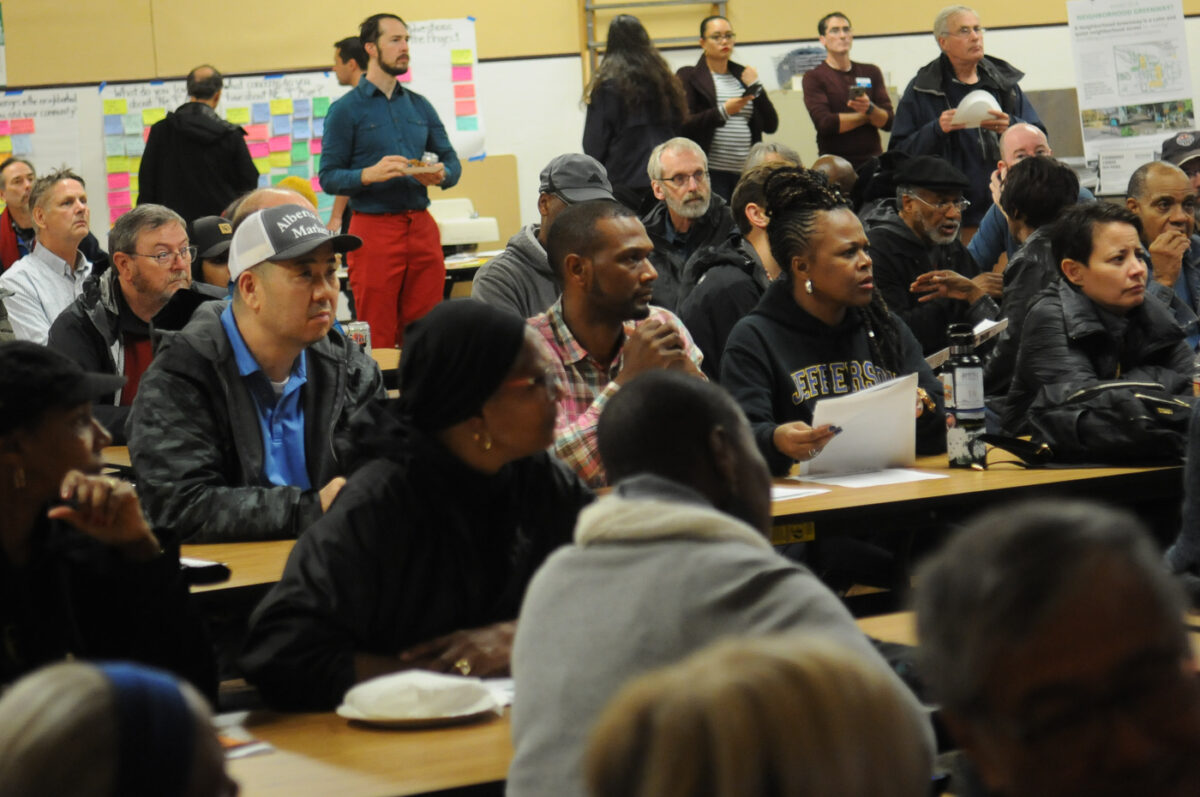
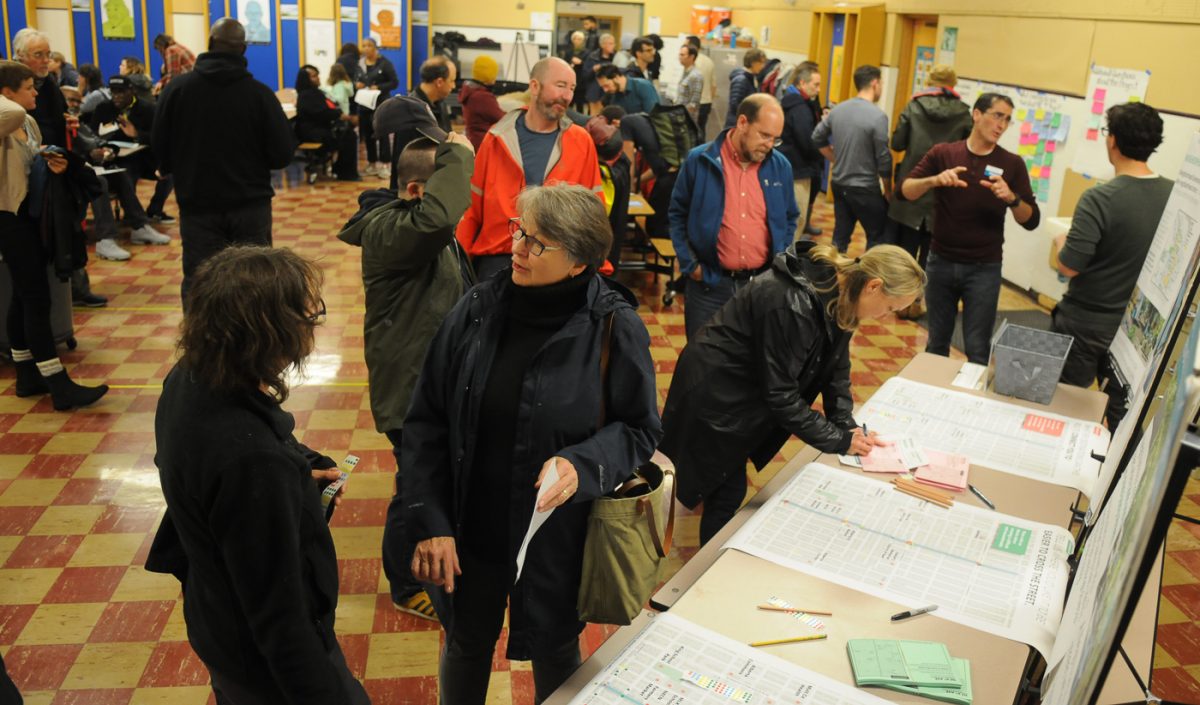


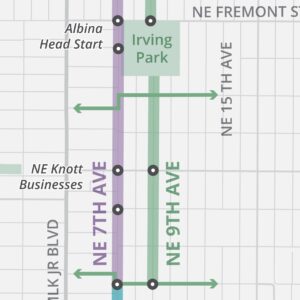
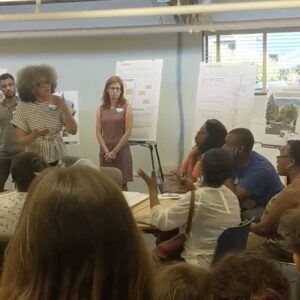

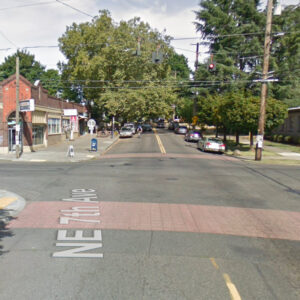
Thanks for reading.
BikePortland has served this community with independent community journalism since 2005. We rely on subscriptions from readers like you to survive. Your financial support is vital in keeping this valuable resource alive and well.
Please subscribe today to strengthen and expand our work.
I’m really disappointed that I didn’t know about this! (I would have been there.) I only live 8 blocks away and use this crossing multiple times a week. It’s sad that even the idea of *slowing* down traffic is so contentious.
Patrick, I’d encourage you to fill out the survey to make sure PBOT knows how you feel https://www.surveymonkey.com/r/335F398
“Greenways are GREAT! Furthermore, not in my lifetime but for my daughter benefit, we must encourage forward thinking to reduce climate change. It is no doubt that our driving habits will look EXTREMELY different in 40 years and encouraging low-greenhouse gas transportation (WALKING) is being on the right side of history. We should prioritize decisions for the younger generation and not let curmudgeons slow good decisions.”
For many people the solution to the climate crisis is a autonomous EV with a million mile battery (Tesla). The only thing different about driving in 40 years may be that we don’t drive ourselves. There’ll be a mile of cars down 9th but no one will care cause they’ll be in the backseat watching screens.
Not so much against slowing traffic, but diverting it. MLK is extremely terrible during rush hour. MLK needs a dedicated bus lane.
>>> it’s quite sad that she’d rather have free ROW parking than to keep her children and grandchildren safe. <<<
That's not really what she said; it's not a binary choice between this and that. But, more to the point, this shows how important the issue is to your neighbors, and may offer a clue why PBOT is so reticent to remove parking.
(And I agree with you that a nice bike facility would help your property value more than on-street parking would.)
I love it when people with NO historical knowledge of the impacts that repeated gentrification has had on a specific population believe they are qualified to make decisions for the impacted yet again. I have to wonder if those very people don’t have the knowledge or just don’t care about it! Homeownership is something that is taken for granted by some, but others died for the right, so yes when the City or any government entity makes a decision to impact ones property, no matter how small, it matters. There are other ways to assure safety without encroaching on a person’s property…
When traffic can no longer cross Killingsworth at 9th Ave, cars will search for alternative routes. That means those of us who live on Emerson, Roselawn, Sumner, and Webster will feel the impact. Since many of those streets only go from 9th to 13th with no other outlet, cars will flow down our narrow streets, making our children unsafe – no place to play in the street as they do now! How many of our cars will be sideswiped by annoyed drives speeding through trying to find an outlet? How safe will out children be as they play basketball in the street or as they ride their skateboards? Instead of being able to go N on 9th, turn left on Killingsworth to enter MLK or continue W, I will be forced to try to enter MLK from one of our side streets, which is always a nightmare. Unless you actually live here, you don’t know what that is like 🙁
As someone who walks in this neighborhood, I believe in safety and am all for crosswalks. Add one with flashing lights to make sure cars can see pedestrians/bikers at night (like they have on 30th & Killingsworth), but to put in a diverter is not a well thought out plan. The impacts will be great and once again the voices of the historically impacted community will be overlooked, go unheard.
Part of equity means remembering where we have been and NOT repeating the same mistakes again. Don’t allow the voices of those who have been here the longest and remember feel as if they are not valued. Compromise can be made, but when you have been here five minutes, don’t think you have the right to make demands just to suit your needs, especially when you won’t be here in another five minutes – ijs
Do the kids on 9th deserve to play basketball or skateboard in the streets?
As someone who lives on NE Sumner between 9th and MLK, I WANT that diverter at 9th and Killingsworth! All of the streets that you mention (NE Webster, NE Sumner, NE Emerson, and NE Roselawn) already suffer from a glut of cut through traffic! That cut through motor traffic already ignores the 20 mph limit, often by 2X, and already treats the stops signs as little more than yield signs. The streets in the neighborhood are already unsafe!
I have little doubt that a diverter at NE 9th and Killingsworth will reduce the cut through traffic in the neighborhood, and let’s remember that it is just that, a neighborhood. It is not some convenient auto bypass, which is how it is currently used. I also have no doubt that a diverter at NE 9th and Killingsworth will make accessing my own home in the neighborhood far less convenient, but if it reduces and slows the traffic on my neighborhood streets then I am all for it. I won’t be gone in 5 minutes, I live in the neighborhood, but do you know who is gone in 5 minutes? All of the current cut through auto traffic is gone in 5 minutes (really like less than a minute given the speeding and lack of obeying the stop signs), and I could care less if they are are inconvenienced and are no longer able to cut through the neighborhood.
I wonder if people will go around via Church St?
I think it would be a good move to stop calling it a hood, the hood, or your hood.
It’s more difficult to say, “yes” and work to accommodate something new than it is to say, “no” and go along with the status quo. “No” comes from a scarcity mindset where change can only come from a perceived “loss” and creates conflict. In this instance it comes from a lack of influence and control within a community that has suffered under past city policies.
Portland as a community and city needs to change to welcome new people and ideas. It also needs to prevent displacement that has ravaged west coast communities such as the Bay Area and Portland.
As a someone born in Portland, I take issue with the claim that people moving here “should not” have a say in the evolution of the city or are somehow “ruining it.” It pains me to hear it. This is not a dichotomy. Both can be true if the conversation moves beyond scarcity and a willingness towards collaboration.
Locking neighborhoods into points of time is not a good strategy for people born here nor for residents moving here. Doing so compromises future generations’ ability to select housing by artificially limiting supply and limits transportation options by allocating too much public space to the storage and movement of private cars.
I understand that people of color interactions with police have disproportionate fatal outcomes. Cars offer a means to move “covered” through public spaces. They also disproportionately kill Native Americans and blacks more than any other racial group. Police reform must happen simultaneously with transportation reform to welcome everyone on board.
The area has changed over the decades and continues to adapt to accommodate growing, changing populations. The past should be honored with measures to address past injuries (e.g. police reform, affordable housing, investment in public schools, rent stabilization, etc.) and provide safer streets for everyone with access to opportunity outside of the car. These are not mutually exclusive outcomes.
The wealth of ideas and cultures are what makes a city great. We need to support each other, not fight each other and instead address weak policies that preserve status quo. The city’s inability to efficiently move people in public spaces due to car dominance and the inability to develop land effectively to house more people are two of the greatest culprits. That includes additional work. We need both old & new.
I agree that PBOT needs to get ahead of disinformation and stop letting the conversation end. I hope a safer route that avoids the worst climbs up Alameda Ridge are developed for all ages and abilities and people have a willingness to be open to change that will save lives.
I think what we need are for planning to be less top-down and more bottom-up. People are much less resistant to change when they feel they have some control and influence over what happens, how fast, and how much.
The concerted effort to disempower community groups (because they get in the way of “progress”), probably only increases resistance to top-down initiatives.
I am SO tired of the newcomers-not-welcome attitude. Trumpism writ small. 🙁
I don’t understand how 9th is a “throughway” that is an alternative to MLK or 15th, since it is bounded by Irving park to the south and the dekum triangle to the north. Does a jog over to 7th count as part of the calculus?
I truly think that the day is coming where the silent folks will get tired of the heavy handed folks downtown who more than likely do not use the streets that they are changing. When I talk to the project managers on the phone and a conversation comes to the process behind this or that it ultimately ends in silence. I often wait it out just to add a level of uncomfortability. Why? Because very little of these changes directly affect them. The most damning part of what is happening around town is what I witnessed at the SE Lincoln open house about this time two years ago. It sounds much like this event. Plenty of opposition and plenty of dumbfounded looks and back peddling from PBOT. What ended up happening? You guessed it. More traffic on other streets thanks to the mostly unwanted diverter. What happened on NE Glisan recently? 60% of the residents were against the lane diets. What did PBOT give them? Diets. If PBOT can’t be trusted to come up with ways for their lofty goals to be met while also serving the residents then really, what good are they? This way of doing business, yes business, can only last so long. I bet this diverter is going in as a “temporary” option that never actually leaves.
You know what’s going to happen if a diverter goes in — people will be forced right or left then flip a U turn to go their desired direction. I see it all the time and have even done it myself when I’ve come upon them by accident and didn’t want to be rerouted (shamed to admit).
You are right that some people will do this; some when they happen upon it for the first time, then learn not to come that way again, some who will do so habitually until they grow tired of it.
And none of that means the diverter isn’t effective or a good idea, because it will divert most people most of the time. It doesn’t need to be 100% effective to be completely effective.
DH,
RE: Lincoln Greenway: How much traffic on what other streets? Do you even know?
https://www.portlandoregon.gov/tRANSPORTATION/article/741232
https://www.portlandoregon.gov/tRANSPORTATION/75123
Is it really that much to ask, that there be some streets where a family can ride bikes without being tailed by an aggressive commuter trying to cut through a neighborhood?
–
I live on a controlled entry street. Sure, it means I have to jog a few blocks around my neighborhood. But, good grief, it’s not that big a deal! I can still drive to my freaking house, it’s just a few seconds longer. And, for my trouble, I get to live on a quieter street! It’s totally livable. What are these people so, so afraid of???
“What are these people so, so afraid of???”
You mentioned your experience, in which your neighborhood had something done to it (access control added to your street) which ended up working out well. It may have even added at the request of the neighbors.
Now imagine if instead of that, your neighborhood had something done to it (in the form of street changes, zoning changes, development projects…) that forced you or your relatives or neighbors to lose their businesses, or have their livability, safety or home values wiped out. Then imagine that happening to you and your neighbors several times over the course of your residency there.
On top of that, imagine that each of those devastating changes had come with promises it would improve things, maybe promises so enticing you’d even supported the changes, and maybe even told your reluctant neighbors that things would turn out well.
I’d guess it would make you wary of changes.
This isn’t a comment against the diverter, but my opinion of why some people might be reluctant to agree to it.
Whether one prefers a diverter at 9th and Killingsworth shouldn’t matter much. What should matter is data to support that the diverter is a solution to a problem. The PDOT slide showing seven t-bones of unspecified severity, and zero pedestrian or cyclists involved collisions over the past five years, is hardly convincing. pdx.maps.arcgis.com goes back to 2007 and shows nothing involving pedestrians or cyclists, and a single motor vehicle collision with an injury.
Those enamored with ambitious concepts are going to face push back, and when that concept is apologetically presented in the context of ‘transportation-related trauma and pain’, rather than simply thoughtful change open for discussion, an outcome like last night is predictable.
Incremental improvements pitched to individuals, over bold visions pitched to groups, will alway have a greater chance of coming to fruition. Let’s add some speed bumps, painted crossings, and objective speed enforcement, then call it good until proven otherwise and move on to more pressing areas.
There’s a decades-long history of that neighborhood having changes either shoved down its throat, or made based on false reassurances. The skepticism towards changes proposed by any government agency is logical and shouldn’t surprise anyone.
If this diverter is a good idea (I don’t know one way or another) and it doesn’t go forward, don’t blame neighborhood opposition, blame the agencies that have done so much harm to that neighborhood over the last decades.
None of this is news to anyone.
Keeping parked cars back from crosswalks and intersections isn’t the stuff of neighbor voting. It’s how fast people perceive and react, and how fast vehicles brake. It’s the stopping sight distance table in the AASHTO Green Book—adopted nationally, and in Portland in the 1993 Design Guide for streets and TRN-1.10 and I suspect long before. It’s illustrated in the MUTCD, specified in the Uniform Vehicle Code, legislated in ORS 811.550(17), and beefed up in Portland City Code. It’s engineering. People not crashing into each other. Life and death. It’s not “hey that’s my parking spot.” It’s not PBOT leaders mumbling “yeah other places do it differently” and looking at the floor. Years of conversations about this, every one a dead end.
I was under the impression that Portland’s city code actually runs contrary to the statewide prohibition of parking right up to the intersection in that Portland’s parking signage, paint, etc. generally direct people to park right up to the crossbar. Of course, Portland could make a substantial improvement in non-motor vehicle road user safety by making signage changes to allow for non parking zones at each intersection so users have clear lines of sight, but I’m guessing that would be a huge expense that Portland does not want to make.
“We recognize that many of you in this room and in this community at large have experienced transportation-related trauma and pain.” Lol. What does that even mean?
I love the diverters they put in in my neighborhood, but apparently King resident’s would rather be butt-hurt than have safer streets. Your loss ***word deleted by moderator***
Rudi V “I’m not going to take any time to understand why King residents don’t want a diverter, and I just can’t understand why they don’t take the time to understand why it’s a good idea.”
If people from outside of the King neighborhood want a greenway in the King neighborhood, then they probably need to engage directly with the people of the King neighborhood. Whether or not it should be PBOT’s role, it seems like they may not be achieving the results that some want.
Cycling advocates should gather residents of other neighborhoods that have greenways and provide some perspective to residents of the King neighborhood. Real people who live in similar neighborhoods with real-life experience can do a lot to shape opinion. Something along the lines of “I was skeptical, but after some negotiation we came up with a solution we could all live with, and now I’m so glad we have the greenway and the traffic calming measures.”
That’s a very nice idea, but is that really the way things are or should be done? This is the reason we elect a government.
I did not attend the meeting, mostly because I don’t live in that neighborhood, although I do walk through it. If the post it notes from the photos in the article are an indication of the thoughts and feelings of the folks in attendance, there is much more work to be done as far as communication goes. Just to take one of them for example: “no speed bumps please. Diverter on 9th and Tillamook instead.” Tillamook is already a neighborhood greenway and does not have nearly as much through traffic, especially since the street is cut by 7th. Also, Killingsworth is 19 blocks north of Tillamook. How does this even address the issue of the meeting? And were speed bumps part of the diverter proposal? That’s just one of the notes, so it does seem the poster who was there who mentioned a lack of active listening was probably right.
Hmm… is it necessary to make explicit that the word deleted above by the moderator was not any sort of racial slur? In in PDX, with all the hysteria that involves, I kind of think it is.
Remember that skinny little white hipster rapper from the 90s, “Beck”? He had a popular song titled with the word I used.
It does not include the bridge over I84.
>>> e.g., idling cars don’t cause more pollution than cars moving. <<<
Isn't the issue that the drive time is longer when stuck in traffic. The 20 minute drive becomes 45 minutes with traffic and more pollution is generated because of it.
Actually, the study acknowledges that speed is a factor, but claim if traffic is not stop-and-go, it will induce more diving that will offset the benefits of reducing idling.
GOOD NEWS! PBOT is breaking ground on building this divider this morning!
Jonathan: I have sent photos to your email. GO ahead and use with credit.
My email wasn’t working with attachments so I sent it via FB Messenger. Feel free to delete these “business” messages on your blog.
Yikes. Sounds like a mistake then. Look how PBOT absolutely botched Fessenden and are redoing all the speedbumps there — could this be another thing we’ll have to pay to take right back out?
You know….why waste time on this neighborhood twice? Let them have a car centric neighborhood while others go up in value. They can either take it leave it. The city is wasting valuable time futzing around. The damage was done years ago and unless pbot is going to write a reparations check, move on
Why? Because 1) there are safety problems that remain, and they affect thousands of people, 2) lots of people who live there and/or use the streets do want the changes, and 3) the mistrust of the City that’s at least partially fueling the opposition is the result of the City (plus ODOT, etc.) doing things over and over to that neighborhood that created the distrust in the first place.
PBOT should not abandon this critical piece of the network of safe routes for bikes. If we are serious about getting people to use bikes as transportation, then we need an actual network aof safe, direct and connected routes for people to use. Abandoning a route just because one neighborhood wants to be treated like a gated community is a horrible idea and is fundamentally at odds with transportation planning. Just because a road goes through a community does make it the property of that community. Part of the value of the road lies in its potential for local placemaking, but another valuable part of the road are the connections it makes to other places. PBOT must respect the communities it works in, but that respect must have some limits when it comes to decisions about safety and connectivity.
Why should Portland get a voice when discussing state and federal highway changes such as the Rose Quarter Expansion?
“Abandoning a project just because one city wants to be treated differently is a horrible idea and is fundamentally at odds with transportation planning. Just because a road goes through a community does make it the property of that community. Part of the value of the road lies in the connections it makes to other places.”
The diverter issue is just a proxy for another war that this neighborhood wants to have. Look at it this way. Largely in the African American culture, cars are good (they mean you have “arrived”) and bikes are for kids or if you have a DUI. So doing anything to slow the car is to, you know, keep the African American down and remove car use. It’s just the way things are for now.
Until African American Culture changes to embrace bikes as a positive, then they will fight all street changes.
And look, it’s not as if European culture aka “white” culture has largely embraced bikes either. It has though just enough to allow some around the edge changes. And we/they still kill thousands with the cars….and fight against diverters.
“They” are not a unified block, and your description is too simplified.
It’s also not backed up by the comments of people in the article, who weren’t identified by race, but were opponents of the changes. They had a variety of reasons for opposition. Some mentioned the changes could have positive impacts. Some mentioned concerns about things like increasing cut-through traffic–the same types of concerns proponents have about traffic.
One comment stood out to me–the woman who was concerned about inability to make left turns, and emergency access being limited. She was in the neighborhood when (or just after) MLK, Jr. Blvd. was rebuilt by ODOT to serve through-commuters better at the expense of its function as a community main street. Many left turns were restricted by the median, businesses’ parking was removed, etc. Utility poles were even relocated off of MLK into people’s backyards up and down MLK so it looked better to commuters. Long after the median went in, policies were created to move traffic in and out of MLK businesses from accessing businesses via MLK to going out the sides or backs of businesses onto the residential streets.
And the MLK reconstruction was just one of several projects that were inflicted on that area, with disastrous impacts after promises that they were improvements.
So I’d be wary myself, and it’s not do to thinking cars are good and bikes are bad.
The majority of people that die on Portland streets are using motor vehicles at the time.
I live in NE Portland near 8th and Knott. I’d love to see a diverter or two but I’ll find a place to ride my bike regardless.
The hardest street crossings I encounter are actually Fremont and Prescott, and yes I go past Killingsworth.
It’s positively dangerous to cross Fremont on foot. Good look shaking your foot out there.
The car most likely to be seen rolling a stop or storming a crosswalk is a Subaru or midsize SUV with a carseat.
Re: Killingsworth, Fremont, and Prescott crossings
I too drew attention with the online survey to these three crossings as being challenging during peak commute hours to get across.
It’s interesting to read all this. Vancouver, BC went through a similar thing in the 1980s when two neighbourhoods got extensive traffic diversion. At the time it was the end of the world but it was pushed through and now those are the most desirable neighbourhoods in town and while people still grumble about having to drive home in an indirect way, they do acknowledge that it’s better.
I see this diverter as being a pretty mild intervention so am surprised at the reaction. Maybe they should have proposed something more extreme and then had room to water it down to this.
I think it’s important to remember the context of having been screwed over by planners and their road building and upzoning, which may make people extra wary about doing things that they believe, however mistakenly, will lead to further damage to their community. Especially if they feel those ideas are being pushed on them by outsiders. That, and what mark smith wrote above.
I agree with you that it’s short-sighted, but I do not live in that neighborhood, and I think all communities deserve a very loud voice over what happens to them, even if I don’t always agree with what they decide.
I do not believe that property owners who happen to live in expensive neighborhoods, like this one, deserve the right to limit safety improvements that may benefit any and all people who may travel *through* the neighborhood. What an insidious use of privilege! Just because you have this house in this neighborhood, you feel that you have the right to dictate the safety conditions of anyone passing through? That’s so toxic!
Safety is one facet in a complex series of tradeoffs. No one here values safety higher than everything else, otherwise we’d never get on a bike. We’re all willing to accept some level of risk because it allows other important things to happen.
You are saying that your valuation of risk should take priority over that of other people, in their neighborhoods, just because you occasionally ride your bike there. Isn’t that also an expression of privilege?
Honestly, after getting hit by a truck years ago, I think being alive is itself a privilege, and it’s a privilege I’d like to maintain. Furthermore, I do think that Vision Zero, if it has any meaning, implies privileging vulnerable road users over the interests of property owners in expensive neighborhoods such as this.
–
If the City doesn’t make policy with VRU at heart, then Vision Zero is just a flashy marketing campaign, and people will continue to lose their lives at the altar of motor vehicle speed and convenience. That would be unethical.
What really stands out for me is how PBOT made such a huge effort to acknowledge the history of institutional racism, have Millicent make her statement, etc, and it didn’t seem to move the needle at all.
Are black folk in this neighborhood out on their bikes? Seems to me that if you aren’t out on your bike, you will never see the utility of the diverter – even if cars are plowing into one another. Remember that car accidents happen to other people, and when they do, they are usually an insurance headache. Cyclists pay the ultimate price.
This sounds like a very important point; if it’s only “them” who are riding bikes, then “their” infrastructure is being imposed upon and inconveniencing “us”.
This is not inherently a racial dynamic; it may well be at play in other communities that have been less receptive to bike infrastructure. See my earlier comment about top-down planning vs. bottom-up.
Yes, once people start seeing something as “us vs. them” progress is tough.
At least (I hope) the meeting wasn’t set up the way some street design meetings I’ve been to have been: “OK, now let’s hear from our audience. Let’s alternate between bike people (includes people who walk) and neighbors”.
Also, while it was great PBOT acknowledged shortcomings in their previous design (“We got it wrong…”) that also may lead people to remember that PBOT was defending that design, right up to the point they weren’t. The obvious question becomes, “Why will this time be different?”.
It’s not surprising that people who supported the diverter (40% of the audience) didn’t speak up about it. These meetings have been contentious and stressful to attend. If the community were actually surveyed door to door I would guess that public support would be even higher. I don’t know how many meetings PBOT expects the public to attend to start this project. This is #4? in the past year, and we haven’t even covered Irving park yet.
Well, few people are willing to stand up and defend an incremental traffic safety improvement if it risks getting shouted down and being accused of being a racist bigot.
re: The whole myth of “idling creates more pollution” thing…
Imagine a big mile-long oval racetrack with 100 cars parked around it, and your house is next to the finish line. The cars’ gas engines are off, and zero emissions are being made. Now everyone starts their engine and idles for an hour. Engines idle at ~.125 to .25 gallons an hour. So 100 idling cars are using 12.5-25 gallons per hour. NOW, everyone starts moving and driving along at 30 miles an hour, completing 30 laps. 100 cars, going 30mph and getting 30mpg, are using 100 gallons an hour total. So that’s 4-8 times as much fuel being used, and harmful emissions being made. PLUS you have the added noise of a car passing your house 3000 times…
I’ll take a street full of idling cars over one full of fast traffic, but better yet divert a lot of the cars and just give me bikes.
OMG, if people cared about idling, we wouldn’t have drive thrus, and people wouldn’t idle in their parked vehicles all the time for no reason whatsoever. Walk around the city sometime and count the parked cars with their engines running while someone inside checks their email, reads a book, eats lunch, waits to pick someone up from school, etc.
I have knocked on a few windows to ask people to turn off their engines, but it’s pretty much pointless, and they are usually confused as to why I’m asking. I had a company in my neighborhood spraying markings on the pavement, and the driver left his engine running for half an hour in front of our house. I asked him to shut it off and he drove it around the corner and parked it again with the engine running. Same experience with an Uber driver who was hanging out in front of our house waiting for a fare. Same thing when I visited my son’s environmentally-focused middle school for conferences….multiple parents sitting in their cars with their engines running.
…on the wrong side of the street, with the high beams on.
Looks like a program we need here.